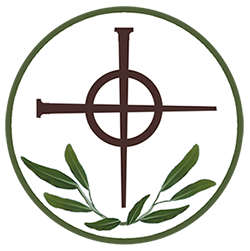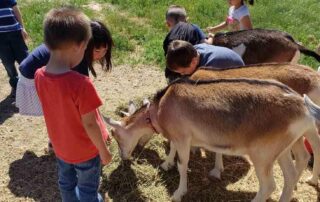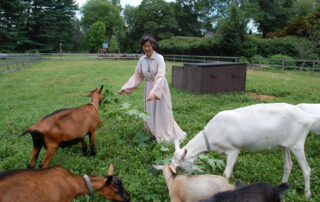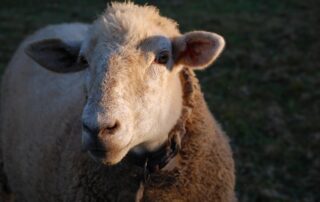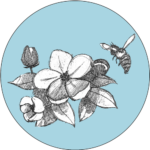 Pillar: Relationship
Pillar: Relationship
Laudato Si’ Action Plan Goals: Ecological Spirituality, Ecological Education and Ecological Economics
 Pillar: Relationship
Pillar: Relationship
Laudato Si’ Action Plan Goals: Ecological Spirituality, Ecological Education and Ecological Economics
Group (Grade Levels): ages 7 and above
Learning Goals:
- experience basic animal care.
- approach different animals as an analogy to approaching differences in people.
- learn where food (specifically meat) comes from, and how the nourishment animals provide is part of God’s plan of creation.
Materials Needed: Space to access livestock; quiet environment; animal food; tools for animal care: grooming tools, pitchforks, shovels, rakes, wheelbarrows; space for composting animal waste: field or compost bin; fresh straw for animal enclosure after cleaning; basic First Aid kit
Estimated Time to Complete Activity: Variable
Estimated Number of Sessions if Activity Continues: Variable
Pre-planning
- Contact and coordinate with the owner of the animals being used in the activity.
- Arrange transportation.
- Safety precautions: Ensure participants wear closed shoes, preferably heavier; survey the area before the activity to check for any hazardous objects.
General Outline of Experience
- Scripture passage and suggested introductory questions: 1:24-26
- Then God said: Let the earth bring forth every kind of living creature: tame animals, crawling things, and every kind of wild animal. And so it happened: God made every kind of wild animal, every kind of tame animal, and every kind of thing that crawls on the ground. God saw that it was good. Then God said: Let us make human beings in our image, after our likeness. Let them have dominion over the fish of the sea, the birds of the air, the tame animals, all the wild animals, and all the creatures that crawl on the earth.
- What do you think the word “dominion” means in this passage? (Lead group to understand that God gives to man the care of the earth by giving “dominion,” or leadership. Sometimes the word “dominion” has been misused to imply that humans are masters and dominators of creation, but this is not a correct interpretation of the Scriptures. Sometimes we use the word “stewardship” instead of dominion to make this point clear.)
- What are you stewards of in your life?
- Then God said: Let the earth bring forth every kind of living creature: tame animals, crawling things, and every kind of wild animal. And so it happened: God made every kind of wild animal, every kind of tame animal, and every kind of thing that crawls on the ground. God saw that it was good. Then God said: Let us make human beings in our image, after our likeness. Let them have dominion over the fish of the sea, the birds of the air, the tame animals, all the wild animals, and all the creatures that crawl on the earth.
- Laudato Si’, n. 86:
- “God wills the interdependence of creatures. The sun and the moon, the cedar and the little flower, the eagle and the sparrow, the spectacle of their countless diversities and inequalities tells us that no creature is self-sufficient. Creatures exist only in dependence on each other, to complete each other, in the service of each other.”
- How do you see this interdependence in your life? Name some plants, animals, and people who you rely on and on whom you rely.
- How do creatures provide sustenance for us?
- “God wills the interdependence of creatures. The sun and the moon, the cedar and the little flower, the eagle and the sparrow, the spectacle of their countless diversities and inequalities tells us that no creature is self-sufficient. Creatures exist only in dependence on each other, to complete each other, in the service of each other.”
- Supplemental Catechism of the Catholic Church quotation (CCC 2416-17):
- “Animals are God’s creatures. He surrounds them with his providential care. By their mere existence they bless him and give him glory. Thus men owe them kindness. We should recall the gentleness with which saints like St. Francis of Assisi or St. Philip Neri treated animals. God entrusted animals to the stewardship of those whom he created in his own image.198 Hence it is legitimate to use animals for food and clothing. They may be domesticated to help man in his work and leisure.”
Orientation to tools/elemental techniques:
- Set out tools to be used in the activity: grooming tools, wheelbarrows, pitchforks, shovels, gloves, muck boots.
- Have food on hand to feed the animals.
- Demonstration of how to use tools and best practices for best results. For example, explain how to load a wheelbarrow so that the weight is toward the front over the wheel; this will make it easier to carry the load. Also, be sure to make the participants aware of the proper use of the pitchforks so as to be safe around the others in the group.
- Proceed to animal’s enclosure.
- While outside the enclosure introduce the individual or the group to the animal through petting, talking, or singing.
- When entering the enclosure, model how to approach the animal, where to stand or not stand.
- Lead up to key point by asking: How is this approach to the animal similar to approaching a person of a different culture or a different point of view? How is it different?
- Key point: We must always approach others and other cultures with respect, observing and participating when invited. For instance, you can observe how the animal loves to be brushed, but not if you do it the wrong way. Remember, we are in the animal’s living quarters!
- Give each participant (depending on the number) a small amount of food to feed the animals. Show them how to feed the animals without being bitten or making the animals afraid.
- Show them how to groom the animals appropriately, and spend time just observing them and enjoying them.
- Explain to students that we will be cleaning out the animals’ stalls or areas where they spend time.
- Arrange students in groups. Depending on the size of the project, there can be different teams, such as one for mucking and one for wheeling the manure to the compost pile. Tell them it is easier to fork a heavy load with a partner.
- After the mucking is finished and clean straw is laid, and everyone has washed their hands, discuss the experience.
- Proposed discussion questions:
- What did you observe about the animals, both while we were petting, grooming, and feeding them, and while we were cleaning their house? What did it feel like to be close to a large animal? (touch, smell, sound)
- How can you apply what you have learned here to your everyday life? What did the animals teach you about how to relate to others?
- How do we sustain others through our giftedness?
- We explained at the beginning how we need to approach the animal respectfully and with reverence. How does setting limits and boundaries help to keep us safe in our relationships?
- Potential analogies:
- There are different ways to approach different situations depending on who you are with, or depending upon their culture (an appreciation of differences).
- Importance of setting limits and boundaries in human relationships as in animal relationships.
- Interrelatedness between all creatures: we need and depend on each other.
- All are unique: no two of us are the same, just as each creature contributes its own gift to the whole of creation.
- We are all called to provide for others through our uniqueness.
- Admire the area and spend more time with the animals.
- Enjoy food from animals: hamburgers, omelets, ice cream, especially, if possible, from the animals who live on the farm where you did the work.
Cross-references to related experiential activities: Chicken Care, Composting, Cooking Together
Using the By-Products from Sheep Chart prepared by the Farm Credit Knowledge Center, speak about how different animals provide a variety of materials and food for our comfort and nourishment.
Everything-But-the-Baaa-Sheep-Products